 |
The Greek Age of Bronze
Other weapons |
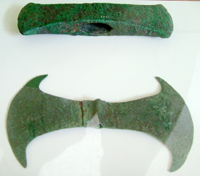 |
| Sling stones are attested in the Agean area since the Neolithic and Early Bronze age both on Greek mainalnd and in the Cycladic islands. Most such projectiles were made of limestone or unfired clay, these particular examples come from Thessaly and date to late Neolithic period. |
 |
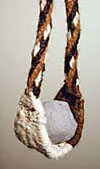 |
The primitive slings were more likely made from animal hair, like this example. The limestone projectiles were adequately smoothing and shaped. The early evidences of these weapons suggest a very informal mode of warfare waged by tribal hordes rather than by organized armies. Indeed a kind of primitive defensive warfare organization was already present in the fortified settlements of the pre-Minoan/Mycenaean cultures like for instance Lerna in Argolis, Dimini in Thessaly or Kastri and Panormos in the Cycladic islands of Syros and Naxos. |
| One of the early possible representation of slingers dated around 2000 BC from the cycladic island of Naxos. |
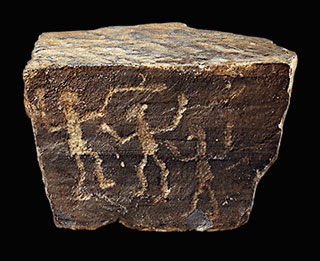 |
| An organized group of slingers is attested in the famous silver "rhyton" from Mycenae shaft-grave IV dated LH IB (about 1550 BC). This representaion of light armed warriors is in accordance with the description of the slingers from Locris as described by Homer in the Iliad (*1). These warriors leaded by Ajax Oileus had no crested bronze helmets to guard their heads, no balanced shields in their grasp, no ashen spears, only their bows and slings of springly, twisted wool. Trusting these, they followed their chief to Troy, shooting with these, salvo on pelting salvo, they tore the Trojan battle lines to pieces. |
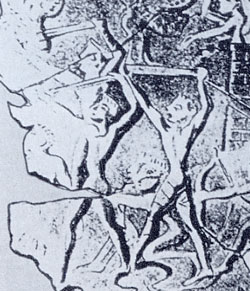 |
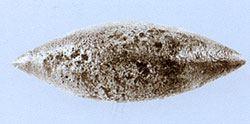 |
The sling bullets were also made of metal as attested by this bronze sling bullet (length 4.8 cm) from Maa-Palaeokastro Cyprus dated about 1200-1100 BC. in Cyprus amygdaloid sling bullets, mostly in lead but also in bronze, appear at several sites of the Late Cypriote Bronze Age, particularly at Enkomi. They also illustrate the military character of the settlement. |
| Battle-axes and hatchets are attested in several Aegean settlements since the Neolithic and Early Bronze Ages both in Greeke mainlad, Cycladic island and Anatolian coast sites. The early examples of these weapons and tools were made of stone and copper. Two well preserved cooper axes of the Final Neolithic period (ca. 4500-3300 BC) have been found in Sesklo,Thesally.They were found together in the center of the acropolis beside a house wall.They were cast in moulds from 99% pure cooper then hammered.Their different sizes show that they came from different moulds |
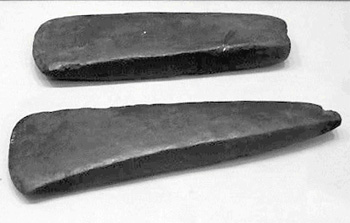 |
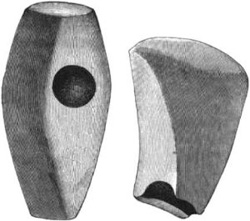 |
Two interesting axes made of stone from Troy. The specimes have been found by Schliemann during his excavation in the lowerest level of the Hisarlik hill so more likely in the Troy I remains dated around 2900-2450 BC |
| An interesting hatchet or chisel made of jade has also been found in the same Troy I level. Even if this specimen was not found in the Greek mainland or Aegean islands this Early Bronze Age tool or similar weapons are worthy to be mentioned being very representative of the type of manufactured goods made in that period both in Aegean and Anatolian areas. |
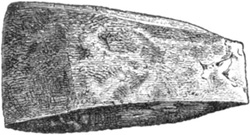 |
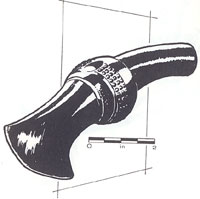 |
In the second level of Troy excavation identified as Troy II dated around 2450-2200 BC four magnificent, highly polished artefacts that truly deserve the name "battle-axes". Three are of greenish stone said to be nephrite, and one bluish one resembles lapis lazuli. Both the exotic materials and the elegant craftsmanship suggest thta these probably come from much farther east-perhaps from Bessarabia. . |
| During the excavation in Troy II level settlement several copper tools or weapons have been found. These blade-shaped objects have been interpreted as battle-axes and they are from above 6 to above 12 inches in lenght, from nearly 1/2 to above 3/4 of an inch thick, and from above 1 to nearly 3 inches broad, the largest of them weighs 1365 grammes. |
 |
 |
 |
 |
Similar copper objects have been also found in the Cycladic islands like for instance these axes of the Keros-Syros culture which are made of arsenical copper and dated around 2700-2200 BC. These specimens attested the remarkable advances in metalwork in the Keros-Syros culture. The heavy-duty shaft-hole axes in this group were perhaps used for felling trees and stripping branches, the large flat axes for splitting tree-trunks into planks and the chisels for finer work. |
| At least 110 copper axes and hammer heads dated around 2500 BC have been found in a beach near the village of Mesi, 800 kilometers northeast of Athens. In the area there were no traces of a shipwreck so the site was probably a coastal area flooded by rising sea level. These tools were probably buried at a time of unrest or war. The hoard would have represent a fortune at the time. |
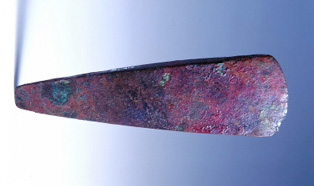 |
Bronze axe from a grave in Lemba Cyprus (Paphos region). It dates to the early phase of the Early Bronze Age (2500- 2400 BC), a period of significant changes in the material culture of Cyprus, possible related to small scale migrations from southwestern Anatolia. Metal axes bear clear evidence for the introduction of copper-technology in the island. They appear at the same time as the pottery style which is associated with the so-called Philia culture. Cyprus was rich in copper and quickly developed its own tradition in metallurgy. By the 14th c BC it was a major centre of copper production and exported both raw copper and finished artifacts all over the Eastern Mediterranean.
|
| A probable battle-axe is also one of the simbols of the still undeciphered disk from Phaistos dated 2000-1700 BC. The simbol above the axe is more ikely the representation of a simple conical helmet. |
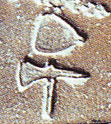 |
 |
A very interesting and highly decorated stone axe in shape of phanter has been found in Mallia Crete. This remarkable specimen is dated around 16th century BC. |
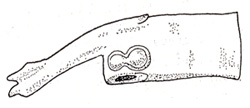 |
Another very interesting specimen is this bronze war-axe with a relief representing on both sides a body shield in shape of eight. This weapon dated around LM II has been found in Vafiò Crete. |
| The double axes are well attested in Crete like this bronze specimen dated around MM III. It is difficult to establish if this kind of axes were used as tools or also as weapons. |
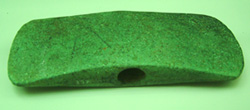 |
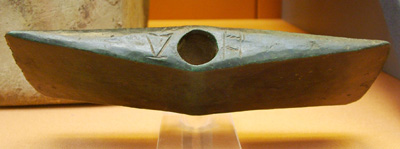 |
A similar bronze double axe dated MMIII-LMI (about 1700-1450) found in the Lasithi Plateau shows two signs in the Linear A script. The double axe was both a tool, weapon and a religious symbol in Minoan Crete. The Linear A inscription perhaps shows that this example was a votive offering. |
| Another bronze double axe from Voros Crete dated LM III shows decoration in both sides. In one side a body shield in figure of eight between two sacral node is represented. I the other side another sacral node is located between two quivers. |
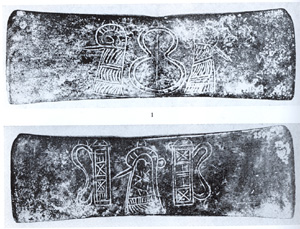 |
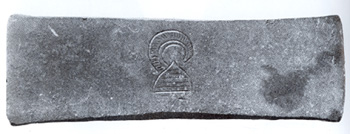 |
A bronze double axe from Knossos dated LM II shows on both sides the representation of a crested boar tusked helmet . |
 |
The typical Minoan double-axe with crescent-shaped blades simbol is attested since the first palace period like the one shown in this Cretule sealing from Phaistos dated around MM IIB. |
The earliest examples of the double-bladed axe as yet dis covered in Crete belong to about the Middle of the Early Minoan Age. One is a small copper axe from a tomb on Mochlos. Miniature double-bladed axes, each with a perforation at the end of its handle like that in the single-bladed Neolithic axe, have also been found. Since they are too large to be worn as amulets, they may have been intended for votive offerings, to be suspended from a shrine or from the wall of a tomb. To suspend objects in this way was a common practice in antiquity and is not unknown today.
Several miniature gold Votive double axes have been found in the Arkalokhori Cave in Crete dated in the Second Palace period. Votive bronze double axes reminescent of these gold ones were also found in the Diktaian Cave among other gifts or offering.The double axe was as significant and as important in Minoan religious practice as the other two objects of cult, the ritual horn and the pillar. Although the pillar has survived in the tombstone, and the horn has survived in the numerous representations of a bull's head with its great, sprouting horns, the symbol of the Minoan Age in Greek history is neither a pair of horns nor a pillar; it is, throughout the whole of Greece and especially in Crete, a double-bladed axe. |
 |
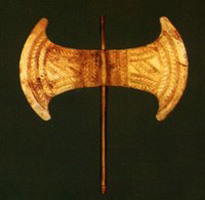 |
One of the most famous Minoan votive double axe is the Arkalochori Axe dated in the second millenium B.C. This axe was excavated in the Arkalochori cave on Crete by Spyridon Marinatos. It is notable for being engraved with an inscription of 15 symbols. Some of the symbols may be identified as Linear A characters, while others are reminiscent of those found on the Phaistos Disc. In particular, the "Mohican" glyph (D02), which is the most frequent character of the Phaistos Disc, appears on the axe inscription both in profile and face-on. |
| Beautiful example of double axe from Zakros Palace, West Wing Room XXV. This specimen is dated LM IB (about 1525-1450 BC) and iy is 48 cm lond. |
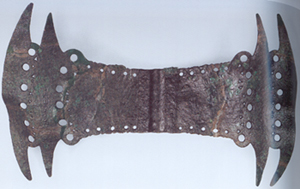 |
| Some of the votive double-axe were made of very thin sheet bronze, some very large, some were made of lead or soft stone. Sometimes the blades were elaborately ornamented. Sometimes the edges were doubled, to turn the emblem into a quadruple-axe, either for artistic emphasis or to symbolize some kind of union or symbiosis. The above image on the right shows a very beautiful example of a bronze elaborate ritual quadruple-axe from the Zakro temple. |
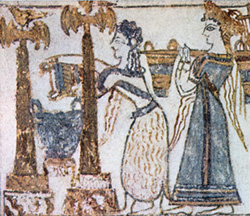 |
 |
The quadruple-axe appears also on the Hagia Triada sarcophagus (1400 BC) and occasionally on seal-stones, jars and in frescoes. The blades of these axes have double edges, which surely render them unfit for practical use. Also the blades are sometimes decorated with what appear to be ribbons or with festoons of beads. Many scholars believe that they are ritual axes, dedicated, like the ritual horns, to the service of the Mother Goddess, a reasonable inference from their frequent appearance in representations of shrines sacred to her. |
 |
 |
| During the course of the excavations at Knossos the archaeologists observed that the west wing of the palace, where the Priest-King had his official quarters, contained an unusual number of double-axe symbols. They were incised not only upon the stone building blocks but also upon the stone pillars in the underground crypts. And small stone axes also stood upon the altar of many a shrine. Someone suggested that the sign of the double axe was merely a mason's mark, but this interpretation found few adherents. |
| Most scholars continued to feel that the unusual number of double-axe signs in the west wing emphasizes the earlier conclusion that a special sanctity was attached to this wing of the Priest-King's palace. |
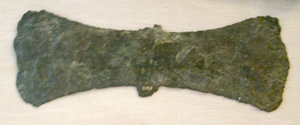 |
 |
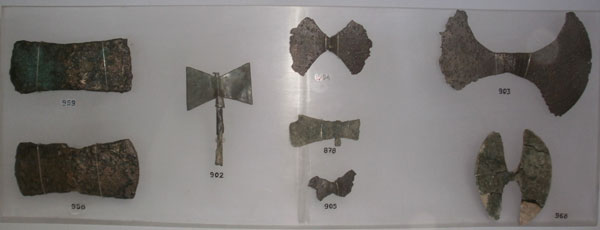 |
Different example of Late Helladic bronze double-edge axes from Pilikata museum in Ithaka |
| The ritual double or quadruple-axe symbol is also present in the Mycenaean iconography like this gold ring from Mycenae dated 15th Century BC. According to Robert Graves (1960), in the Minoan and Mycenaean cultures the ritual double-axe was forbidden to male, which is certainly consistent with the Minoan iconography. The implication of images such as the one on this ring or other similar is that the double-axe was the symbol of a powerful priestess or female deity. |
 |
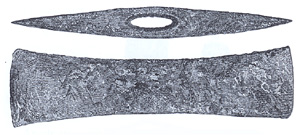 |
Bronze double-edge hatchet has been also found by Henrich Schliemann during his excavation in Mycenae. This specimen is dated around 1550-1500 BC. |
 |
Several example of bronze double-axe, hatchet and pickaxe are attested in Mycenae like these two specimens also dated around 1550-1500 BC. |
| Similar weapons or tools have been found in many Achaean settlements. These bronze double-axes have been discoverd during the excavations around the area of Pylos. |
 |
 |
Some other very well preserved example of bronze double-axes found in Mycenae. These objects have probbaly to be intended as tools even if their utilization also as weapons by low class warriors can't be excluded. |
| A similar bronze double-axe has been also found near the Poros Wall to east of the famous Tomb of Clytemnestra dated 13th century BC.
|
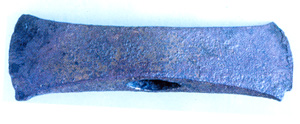 |
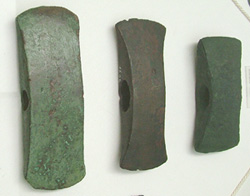 |
Other well preserved examples of bronze double-axe from Pharmakephalo-Sklavoi Crete coming from the Late Minoan period. |
| The lugged or Trunnion axe are rare form. This bronze specimen was found in the Achaea region in an unknown context. It consists of a flat blade with two distinctly protruding trunnions. Similar axes dated during the Late Bronze period have been also found in other Greek mainland sites as well as Crete, Cyprus, the Aegean island, Anatolian and Near East.
|
 |
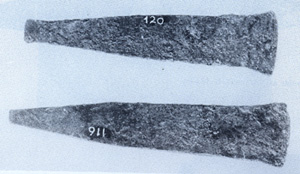 |
Several of these bronze flat axe have been found in the Achaean region and other Greek mainland settlements. Some close parallels are known from Cyprus from hoards which can be dated to the 12th century BC , to which period these examples most probably belong.
|
| different shaped axes have been found in the shipwreck excavation at Uluburun near Kas in the southern Turkey coast . In this cargo ship dated about 1300 BC several Canaanite, Cypriote and Achaean manufactured goods have been found as well as raw material, weaponry and ceramics.
|
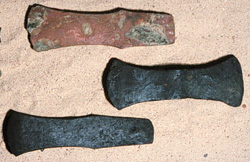 |
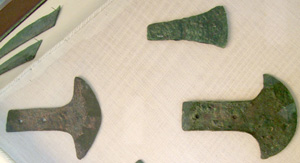 |
Bronze axes with a semi-circular blade dated around XIII-XI century BC are attested in some settlements in Crete.
|
| This kind of Bronze axe is probably brandished by one of the warriors of the naval battle depicted in the krater fragment from Kynosdated dated LH IIIC.
|
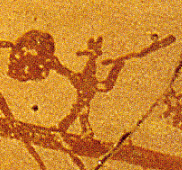 |
 |
Unusual type of copper alloy bronze battle-axe probably dated 1500-1450 BC was found in Vapheio. It is a crescent-shaped, with two large holes (possibly to lighten the blade), while the back is cut out in three teeth. |
| these type of battle-axe are also attested in other Achaean settlements. With these specimens we can understand the feat of Odysseus in sending an arrow through the rings of twelve axes set up in a row (*2)
|
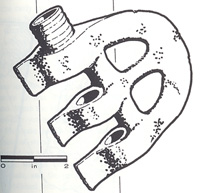 |
 |
A man or priest witht the above mentioned axe is well attested in this seal from Vapheio dated 1500-1450 BC) . |
| A similar battle-axe is probably brandished by a warrior depicted in this pottery fragment from Thebes dated around LH IIIC. |
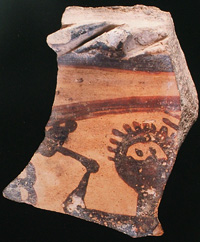 |
 |
From the rest of Europe worthy to be mentioned are some bronze axes found in several Bronze Age settlements from Central Europe and Balcanian areas because their vicinity with the Achaean mainland and because they fall to the same time period as the Greek Bronze Age civilization. |
| Some Bronze Age type of axe distribution in Aeagean and Central Europe area. |
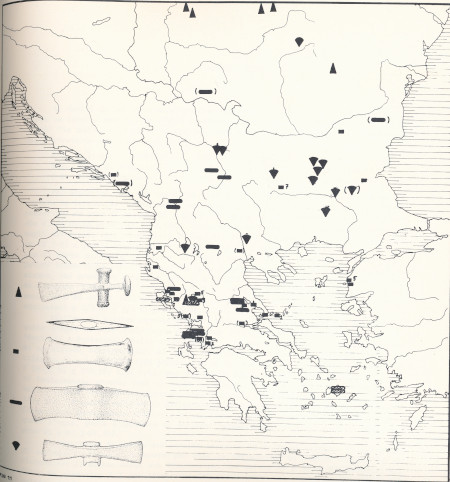 |
| Stone hammer-head fron Crete, probably for ritual or ceremonial use, dated around MMIII-LMI (about 1700-1450 BC) . |
 |
 |
Another well presrved Stone hammer-head fron Zakros Crete, probably for ritual or ceremonial use, dated around LMIB (about 1525-1450 BC). This specimen is 10.3 cm long. |
| Several example of bronze maces or hammers are attested in the Bronze Age sites excavation both in Geek mainland and Aegean areas like for instance this specimen from Loutraki Crete. |
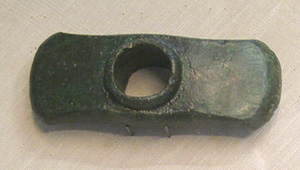 |
 |
Another very interesting massive bronze mace is from Aghia Triada. The utilization of metal maces is also attested by Homer when in the Iliad the hero Areitoos is described as fighting with an iron mace (*3). |
| Also from Aghia Triada it is this other massive bronze mace. |
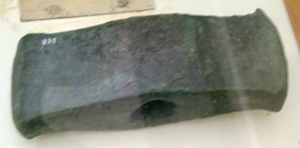 |
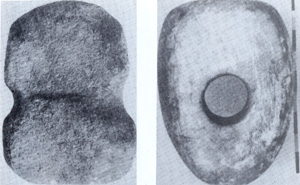 |
Several example of stone hammers in different shape and dimension have been found in some Achaeans settlements like for instance Drakotrypa, Paralimni-Teichos in the Achaean region and in Cyprus. Those were made of different kind of stone like sandstone and limestone. |
| In the shipwreck excavation at Uluburun near Kas in the southern Turkey coast this interesting marble mace has been found . In this cargo ship dated about 1300 BC several Canaanite, Cypriote and Achaean manufactured goods have been found as well as raw material, weaponry and ceramics. |
 |
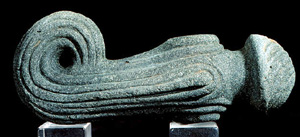 |
Coming from the same Uluburun shipwreck excavation it is this well manufactured stone mace. The general decorative shape of this speciment reminds some Near Eastern and Hittites axes and maces. |
| CONCLUSION
|
| The utilization of sling stones are attested in the Agean area since the Neolithic and Early Bronze age both on Greek mainalnd and in the islands. The early evidences of these weapons suggest a very informal mode of warfare waged by tribal hordes rather than by organized armies. Indeed a kind of primitive defensive warfare organization was already present in the fortified settlements of the pre-Minoan/Mycenaean cultures. Furthermore the utilization of slingers in the final period of the Late Helladic is also attested in the Iliad as well as from some bronze sling bullet.
Another important object in the Minoan and Micenaean culture was the axe in particular the bouble axe which was both used as weapon, tool and cult simbol. Many scholars believe that these ritual axes were dedicated, like the ritual horns, to the service of the Mother Goddess.
Several typology of axes in different shape and material as well as hatchets maces and hammers both in bronze or stone are well attested in the Achaean settlements on Greek mainland, Aegean Island and Anatolian coast locations. Mostly of these specimens were more likely used as tools even if some specific type of maces and axes were certainly intended to be used as weapons.
|
(*2) Odyssey XXI, 120-123 and 420-423.
|
|